News
POP-UP EXHIBITION: NEW ADDITIONS TO THE COLLECTION
From furniture, fashion, and ceramics to graphic design and contemporary craft, the museum acquires several hundred works annually spanning the historic and the contemporary, the unique and the mass-produced. Several of these newly acquired pieces are already on display, including a curated selection located at the entrance to Café Format, showcasing some of the year’s most notable acquisitions.
The collection strategy is closely aligned with the museum’s research and exhibitions, with a particular emphasis on addressing gaps in the historical narrative represented by the collection. In recent years, the museum has prioritised the acquisition and documentation of 20th-century and contemporary design and craft. Visitors can now view highlights from these latest additions at the entrance to Café Format.
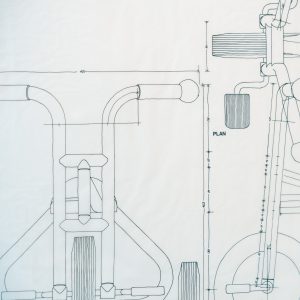
Working Drawing for RABO Tricycle, 1979
The RABO tricycle was awarded the prestigious ID Prize for its constructive, industrial design upon its launch in 1980. Developed with children’s safety, durability and efficient production in mind, the tricycle is tailored to the way children actually ride: with sudden stops, falls, swerves and uncoordinated dismounts. The seat is mounted directly onto the twin steel tubes of the frame, the wheels are small, and the centre of gravity is low.
Gift from Lars Mathiesen og Niels Gammelgaard.

Sun Disc, Acoustic Panel, 2025
Architect and researcher Cecilie Bendixen explores the spatial and sensory potential of textile objects. In Sun Disc, she explores how sound absorption can be given physical form using thread. The acoustic properties of the threads depend on the interplay between fibre distribution and air permeability. The result is not only a striking visual statement, but also a reimagining of the acoustic panel, one that is as sculptural as it is functional.
Gift from the C. L. David Foundation.
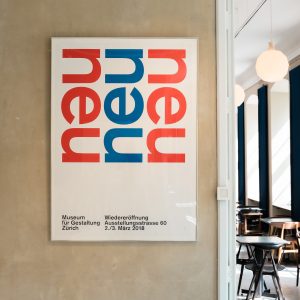
NEU, NEU, NEU, 2018
The Swiss studio Norm Zürich is known for its rigorous continuation of the modernist graphic design tradition that established Switzerland as a global leader in typography and visual communication during the 20th century. Founders Manuel Krebs and Dimitri Bruni turned away from the postmodern impulse to reject rules, instead embracing structure and clarity. Their approach to create “normal” design aimed to communicate with fresh simplicity through order and form.
Gift from Ulla Heegaard.
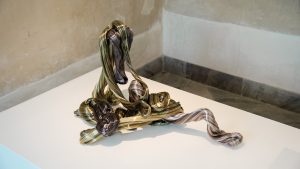
Point of View, 2023
Glass artist Maria Bang Espersen challenges the conventions of glasswork. She stretches and folds hot glass to give it the soft, playful appearance of molten sugar. Forgoing traditional techniques, Espersen experiments freely, exploring the material’s expressive possibilities. Whereas glasswork often demands precise control, she relinquishes it, yielding surprising and organic forms.
Gift from The Association of Friends of Designmuseum Danmark.
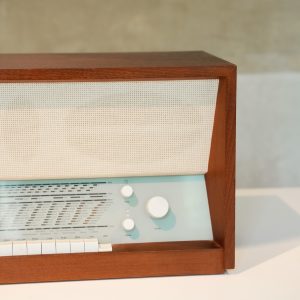
Radio TS31, 1957
The TS31 radio was designed by Herbert Hirche (1910–2002) in 1957 and released to market in 1961. In the mid-1950s, Braun began collaborating with leading modernist designers, including Hirche, Hans Gugelot and Dieter Rams. A Bauhaus-trained designer, Hirche studied under Kandinsky and Mies van der Rohe, and later worked with Egon Eiermann and Hans Scharoun before becoming a professor of design in Berlin and Stuttgart. The radio’s clean, minimalist form is complemented by a “magic eye”, a green indicator that shows how well the signal is tuned.
Gift from the C. L. David Foundation.
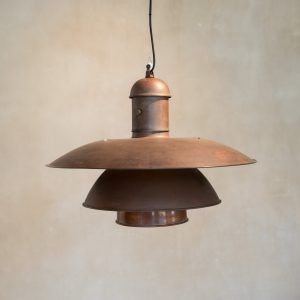
Three-Shade PH Lamp, Prototype, 1926
The PH lamp, designed by cultural critic and architect Poul Henningsen, is a cornerstone of Danish design history, illuminating roughly half of all public and private interiors in Denmark. Henningsen, frustrated by the harsh glare of electric bulbs, embarked on a scientific pursuit from the mid-1920s until his death in 1967 to develop lighting that was soft and glare-free. His solution: a system of tiered shades that direct light precisely where it’s needed. This early prototype, with three copper shades and an adjustable socket, laid the foundation for a whole family of three-shade PH lamps. Including the one designed specifically for Designmuseum Danmark in 1926.
Gift from Hermod Lannung Museumsfond.
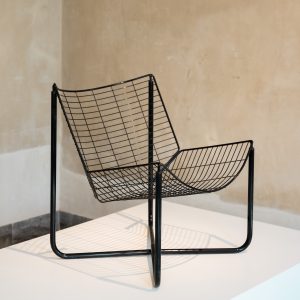
JÄRPEN Chair, 1983
In the early 1980s, Danish designer Niels Gammelgaard experimented with using welded industrial wire mesh to construct seating without upholstery or fabric. IKEA founder Ingvar Kamprad, seeking industrial, low-cost production methods, challenged Gammelgaard to further economise by removing every second wire, provided the mesh holes did not exceed 3 x 3 cm. The result was the flat-pack JÄRPEN chair, assembled without screws. It became a teen favourite and IKEA’s most affordable armchair, selling 4,000 units per week. In 2024, IKEA reintroduced the design.
Gift from Niels Gammelgaard.